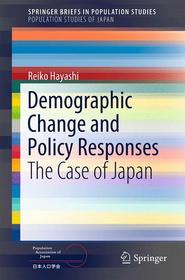
Demographic Change and Policy Responses
The Case of Japan
Series: SpringerBriefs in Population Studies;
- Publisher's listprice EUR 32.09
-
13 309 Ft (12 675 Ft + 5% VAT)
The price is estimated because at the time of ordering we do not know what conversion rates will apply to HUF / product currency when the book arrives. In case HUF is weaker, the price increases slightly, in case HUF is stronger, the price goes lower slightly.
- Discount 12% (cc. 1 597 Ft off)
- Discounted price 11 712 Ft (11 154 Ft + 5% VAT)
Subcribe now and take benefit of a favourable price.
Subscribe
13 309 Ft

Availability
Not yet published.
Why don't you give exact delivery time?
Delivery time is estimated on our previous experiences. We give estimations only, because we order from outside Hungary, and the delivery time mainly depends on how quickly the publisher supplies the book. Faster or slower deliveries both happen, but we do our best to supply as quickly as possible.
Product details:
- Edition number 1st ed. 2024
- Publisher Springer Nature Singapore
- Date of Publication 9 December 2025
- Number of Volumes 1 pieces, Book
- ISBN 9789811304590
- Binding Paperback
- No. of pages67 pages
- Size 235x155 mm
- Language English
- Illustrations VIII, 67 p. 28 illus., 27 illus. in color. 700
Categories
Long description:
"This book explores how people have perceived and acted on the changes in four different population components, namely, fertility, mortality, and mobility, through the creation and development of Modern Japan to the present day. With the highest life expectancy in the world; the highest proportion of the elderly; very low fertility, below the replacement level; and a limited number of international migrants, Japan’s population indicators are unique. Around 2008, the population of the archipelago started to decrease at the same pace as it had previously increased. To understand this phenomenon, it is necessary to look back in history and examine the facts and ideas that shaped the Japanese population. From the Meiji to the Heisei eras (1868–present), substantial changes occurred not only in the numbers but also in the perception and norms that people take for granted. These changes are traced, side by side, through the chapters on fertility control, health and population ageing, urbanization and internal migration, international migration, and international cooperation in the field of population and development. The book illustrates not the uniqueness that isolates Japan from the rest of the world, but the reality of a population that has faced one situation at a time, offering readers a perspective for understanding human society at large.
Traces population change and related policies in Japan since the Meiji era up to the present (1868– present)
" More
Table of Contents:
Fertility:contradicting perception and ambivalent effectiveness.- Health:The origin of universal health coverage to the world’s longest life expectancy.- Policies to accommodate the world’s quickest population ageing.- Urbanization and internal migration:was it policies or population structure?.- International migration: the Lewisian turning point of Japan.- Japanese international cooperation in the field of population and development.
More



